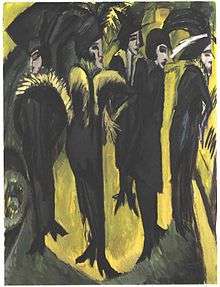New Secession
The New Secession (German: Neue Secession) was an association of expressionist artists organizing joint exhibitions in Berlin 1910–1914.

The New Secession, initially led by Georg Tappert and Max Pechstein, was formed after 27 expressionistic works of art had been excluded from a 1910 exhibition of the Berlin Secession.[1] The first exhibition of the New Secession was advertised as showing artists "rejected by the Berlin Secession 1910", but the group was also joined by artists who were not former Berlin Secession members.[2]
The New Secession helped introducing expressionism in Germany. Besides Berlin expressionists, the New Secession had members from Die Brücke still living in Dresden until 1911, members from Munich, who would later form Der Blaue Reiter, as well as members from other places in Europe.[3]
The fourth exhibition of the New Secession opened mid November 1911 and was a success, but at the same time the group started to fall apart.[4] When Max Pechstein was not reelected as president of the New Secession, he left followed by the rest of the Brücke group. Also, after a split of the Neue Künstlervereinigung München, the Blaue Reiter group now began organizing their own exhibitions.[4] The last exhibition of the New Secession was held in 1914.
Notable members
References
- From pioneer to traditionalist. Archived 2016-01-14 at the Wayback Machine The Atlantic Times. Retrieved 8 September 2015.
- Otto Mueller. Archived 2016-03-04 at the Wayback Machine Liedtke Kunsthandel, Greding. Retrieved 8 September 2015.
- Liebermanns Gegner. Neue Secession und Expressionismus in Berlin 2. April bis 3. Juli 2011. Stiftung Brandenburger Tor. Retrieved 8 September 2015.
- Fulda, Bernhard; Soika, Aya. Max Pechstein: The Rise and Fall of Expressionism. de Gruyter (2012). ISBN 978-3-11-029662-4.